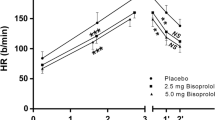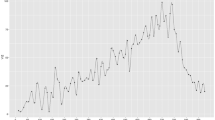Abstract
It has been proposed that β-adrenergic antagonist protection against cardiac events in patients with long QT syndrome (LQTS) may be related to a decrease in baseline QTc dispersion. To determine the effects of β-blocker therapy on QT measurements, we evaluated the exercise tests of 25 pediatric patients with LQTS. Measurements were made of the maximum QTc interval and QTc dispersion during the various segments of the exercise test. There was no statistically significant difference between the pre-β-blocker and post-β-blocker maximum QTc interval during the supine (0.473 ± 0.039 vs 0.470 ± 0.038 sec), exercise (0.488 ± 0.044 vs 0.500 ± 0.026 sec), or recovery (0.490 ± 0.031 vs 0.493 ± 0.029 sec) phases of the exercise stress test. There was also no statistically significant difference between the pre-β-blocker and post-β-blocker QTc dispersion during the supine (0.047 ± 0.021 vs 0.058 ± 0.033 sec), exercise (0.063 ± 0.036 vs 0.063 ± 0.028 sec), or recovery (0.045 ± 0.023 vs 0.052 ± 0.026 sec) phases of the exercise stress test. Therefore, the protection that β-blockers offer appears not to be related to a reduction of the baseline QTc interval or a decrease of QTc dispersion.


Similar content being viewed by others
References
H Bazett (1918) ArticleTitleAn analysis of the time relations of electrocardiograms. Heart 7 353–370
C Day J McComb R Campbell (1990) ArticleTitleQT dispersion: an indication of arrhythmia risk in patients with long QT intervals. Br Heart J 63 342–344 Occurrence Handle1:STN:280:By%2BA38bjtFE%3D Occurrence Handle2375895
L Fridericia (1920) ArticleTitleDie systolendauer im elektrokardiogramm bei normalen menchen und bei herzkranken. Acta Med Scand 53 469–486
A Garson M Dick A Fournier et al. (1993) ArticleTitleThe long QT syndrome in children: an international study of 287 patients. Circulation 87 1866–1872 Occurrence Handle8099317
JT Hii DG Wyse AM Gillis et al. (1992) ArticleTitlePrecordial QT dispersion as a marker of torsades de pointes. Disparate effects of class 1a antiarrhythmic drugs and amiodarone. Circulation 86 1376–1382 Occurrence Handle1:STN:280:ByyD2cjgvVQ%3D Occurrence Handle1423949
M Hodges D Salerno D Erlien (1983) ArticleTitleBazett’s QT correction reviewed. Evidence that a linear QT correction for heart rate is better [Abstract]. J Am Coll Cardiol 1 694
NJ Linker P Colonna CA Kekwick et al. (1992) ArticleTitleAssessment of QT dispersion in symptomatic patients with congenital long QT syndrome. Am J Cardiol 69 634–638 Occurrence Handle1:STN:280:By2C28%2FntlU%3D Occurrence Handle1346947
E Locati P Schwartz (1992) ArticleTitleThe idiopathic long QT syndrome: therapeutic management. PACE 15 1374–1379 Occurrence Handle1:STN:280:ByyD38jmtV0%3D Occurrence Handle1384000
AJ Moss W Zareba WJ Hall et al. (2000) ArticleTitleEffectiveness and limitations of β-blocker therapy in congenital long QT syndrome. Circulation 101 616–623 Occurrence Handle1:CAS:528:DC%2BD3cXhtlGntLw%3D Occurrence Handle10673253
S Paridon (1998) Exercise testing. A Garson J Bricker D Fisher S Neish (Eds) The Science and Practice of Pediatric Cardiology. Williams & Wilkins Baltimore 875–888
SG Priori C Napolitano L Diehl PJ Schwartz (1994) ArticleTitleDispersion of the QT interval: a marker of therapeutic efficacy in the idiopathic long QT syndrome. Circulation 89 1681–1689 Occurrence Handle1:STN:280:ByuC1Mbntlc%3D Occurrence Handle7908611
A Sagie M Larson R Goldberg J Bengston D Levy (1992) ArticleTitleAn improved method for adjusting the QT interval for heart rate (The Framingham Heart Study). Am J Cardiol 70 797–801 Occurrence Handle1:STN:280:By2A1M7jvFY%3D Occurrence Handle1519533
PJ Schwartz SG Priori C Spazzolini et al. (2001) ArticleTitleGenotype–phenotype correlation in the long QT syndrome: gene-specific triggers for life threatening arrhythmias. Circulation 103 89–95 Occurrence Handle1:STN:280:DC%2BD3M%2FovVSitg%3D%3D Occurrence Handle11136691
W Shimizu C Antzelevitch (1998) ArticleTitleCellular basis for the ECG features of the LQT1 form of the long QT syndrome: effects of β-adrenergic agonists and antagonists and sodium channel blockers on transmural dispersion of repolarization and torsades de pointes. Circulation 98 2314–2322 Occurrence Handle1:CAS:528:DyaK1cXotVeku7c%3D Occurrence Handle9826320
W Shimizu C Antzelevitch (2000) ArticleTitleDifferential effects of β-adrenergic agonists and antagonists in LQT1, LQT2, and LQT3 models of the long QT syndrome. J Am Coll Cardiol 35 778–786 Occurrence Handle10.1016/S0735-1097(99)00582-3 Occurrence Handle1:CAS:528:DC%2BD3cXitVCjsbc%3D Occurrence Handle10716483
W Shimizu S Kamakura T Kurita et al. (1997) ArticleTitleInfluence of epinephrine, propanolol, and atrial pacing on spatial distribution of recovery time measured by body surface mapping in congenital long QT syndrome. J Cardiovasc Electrophysiol 8 1102–1114 Occurrence Handle1:STN:280:DyaK1c%2FivVCnsQ%3D%3D Occurrence Handle9363813
W Shimizu T Ohe T Kurita et al. (1995) ArticleTitleEffects of verapamil and propanolol on early afterdepolarizations and ventricular arrhythmias induced by epinephrine in congenital long QT syndrome. J Am Coll Cardiol 26 1299–1309 Occurrence Handle10.1016/0735-1097(95)00313-4 Occurrence Handle1:CAS:528:DyaK28XjsFGg Occurrence Handle7594047
M Silka A Garson (1999) Ventricular arrhythmias. P Gillette A Garson (Eds) Clinical Pediatric Arrhythmias. Saunders Philadelphia 133
M Stramba-Badiale K Goulene P Schwartz (1997) ArticleTitleEffects of β-adrenergic blockade on dispersion of ventricular repolarization in newborn infants with prolonged QT interval. Am Heart J 134 406–410 Occurrence Handle1:CAS:528:DyaK1cXht1GrtA%3D%3D Occurrence Handle9327695
Z Sun H Swan M Vitasalo L Toivonen (1998) ArticleTitleEffects of epinephrine and phenylephrine on QT interval dispersion in congenital long QT syndrome. J Am Coll Cardiol 31 1400–1405 Occurrence Handle10.1016/S0735-1097(98)00104-1 Occurrence Handle1:CAS:528:DyaK1cXjt1SgsLg%3D Occurrence Handle9581741
MA Vos SC Verduyn AP Gorgels GC Lipcsei HJ Wellens (1995) ArticleTitleReproducible induction of early afterdepolarizations and torsades de pointes arrhythmia by d-sotalol and pacing in dogs with chronic atrioventricular block. Circulation 91 864–872 Occurrence Handle1:CAS:528:DyaK2MXktFOitbs%3D Occurrence Handle7828315
AA Wilde RJ Jongbloed PA Doevendans et al. (1999) ArticleTitleAuditory stimuli as a trigger for arrhythmic events differentiate HERG-related (LQTS2) patients from KVLQT1-related patients (LQTS1). J Am Coll Cardiol 33 327–332 Occurrence Handle10.1016/S0735-1097(98)00578-6 Occurrence Handle1:STN:280:DyaK1M7jslaqtA%3D%3D Occurrence Handle9973011
Acknowledgments
We thank Bernard J. Clark, M.D., for his help with statistical analysis.
Author information
Authors and Affiliations
Corresponding author
Rights and permissions
About this article
Cite this article
Kaltman, J., Ro, P., Stephens, P. et al. Effects of β-Adrenergic Antagonists on the QT Measurements from Exercise Stress Tests in Pediatric Patients with Long QT Syndrome . Pediatr Cardiol 24, 553–558 (2003). https://doi.org/10.1007/s00246-003-0436-0
Published:
Issue Date:
DOI: https://doi.org/10.1007/s00246-003-0436-0




